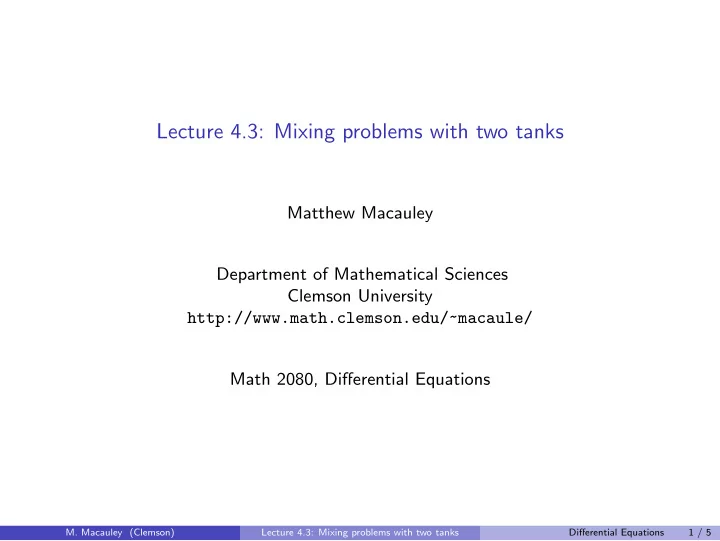

Lecture 4.3: Mixing problems with two tanks Matthew Macauley Department of Mathematical Sciences Clemson University http://www.math.clemson.edu/~macaule/ Math 2080, Differential Equations M. Macauley (Clemson) Lecture 4.3: Mixing problems with two tanks Differential Equations 1 / 5
Motivation Example Suppose Tank A has 30 gallons of water containing 55 ounces of dissolved salt, and Tank B has 20 gallons of water containing 26 ounces of dissolved salt. Moreover: Water with salt concentration 1 oz/gal flows into Tank A at a rate of 1.5 gal/min. Water with salt concentration 3 oz/gal flows into Tank B at a rate of 1 gal/min. Water flows from Tank A to Tank B at a rate of 3 gal/min. Water flows from Tank B to Tank A at a rate of 1.5 gal/min. Water drains from Tank B at a rate of 2.5 gal/min. Find equations x 1 ( t ) and x 2 ( t ) governing the amount of salt in Tanks A and B. M. Macauley (Clemson) Lecture 4.3: Mixing problems with two tanks Differential Equations 2 / 5
The steady-state solution Example (cont.) We derived an initial value problem x ′ = Ax + b , x (0) = x 0 : � x ′ � � − 0 . 1 � � x 1 � � 1 . 5 � � x 1 (0) � � 55 � 0 . 075 1 = + = x ′ 0 . 1 − 0 . 2 3 , x 2 (0) 26 . x 2 2 Since this is inhomogeneous, the general solution will have the form x ( t ) = x h ( t ) + x p ( t ). M. Macauley (Clemson) Lecture 4.3: Mixing problems with two tanks Differential Equations 3 / 5
Changing variables Example (cont.) We derived an initial value problem x ′ = Ax + b , x (0) = x 0 : � x ′ � � − 0 . 1 � � x 1 � � 1 . 5 � � x 1 (0) � � 55 � 0 . 075 1 = + = x ′ 0 . 1 − 0 . 2 3 , x 2 (0) 26 . x 2 2 � 42 � which has steady-state solution x ss = . 36 M. Macauley (Clemson) Lecture 4.3: Mixing problems with two tanks Differential Equations 4 / 5
Summary To solve the inhomogeneous initial value problem x ′ = Ax + b , x (0) = x 0 : � x ′ � � − 0 . 1 0 . 075 � � x 1 � � 1 . 5 � � x 1 (0) � � 55 � 1 = + = x ′ 0 . 1 − 0 . 2 3 x 2 (0) 26 , x 2 2 we take the following steps: � 42 � 1. Find the steady-state solution, x ss = . 36 2. Change variables to convert the system into a homogeneous system, y ′ = Ay , y (0) = y 0 : � 13 � y ′ � � − 0 . 1 � � y 1 � � y 1 (0) � � 0 . 075 1 = = y ′ 0 . 1 − 0 . 2 , y 2 (0) − 10 y 2 2 3. In the next lecture we will learn how to find the solution y ( t ) to this homogeneous system. Our general solution will be x ( t ) = x h ( t ) + x p ( t ) = y ( t ) + x ss . M. Macauley (Clemson) Lecture 4.3: Mixing problems with two tanks Differential Equations 5 / 5
Recommend
More recommend